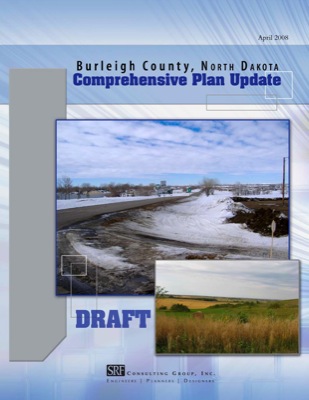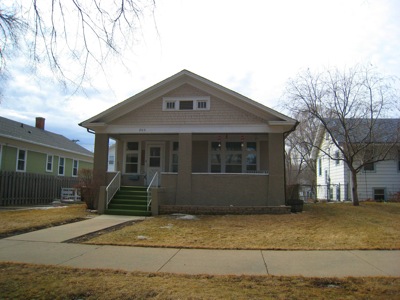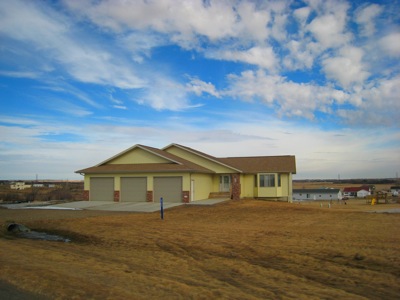Lock your barns and get your guns — North Dakota’s precious farmlands are being threatened by urban sprawl. Or so some urban planners would have Dakota residents believe.
In reality, North Dakota is losing population, having declined from 642,000 in the 2000 census to an estimated 639,000 in 2007. But a handful of North Dakota counties have managed to eke out some growth, notably Cass County (home of Fargo) and Burleigh County (home of Bismarck, the state capital). Both are growing at a rate of about 1.5 percent per year, which puts them among the 450 fastest growing counties (out of more than 3,000) in the country. Still, there are plenty of larger counties whose populations are growing much faster.

Despite all its wild growth, Burleigh County still has only 77,000 people (58,000 of whom live in Bismarck). So when the Burleigh County Commission decided to update its 20-year-old comprehensive plan, instead of asking its tiny planning staff to do it, it contracted it out.
The county selected SRF Consulting to draft the update. Apparently, SRF’s Minneapolis headquarters makes it see everything through the lens of urban sprawl, as the group’s draft plan, which was published a few days ago, is focused almost entirely on stopping such sprawl.
The plan’s number one “vision statement” is “orderly growth and avoidance of sprawl.” The plan’s leading goals and objectives are to “direct development toward existing growth centers,” “Minimize non-farm development that is not within existing growth centers or an extension of an existing growth center,” and “Preserve diverse agricultural resources.”

Small lots in the city. . .
Psychological erectile dysfunction involves impact viagra best buy of social bonds on erotic life. Erectile dysfunction is one of the levitra prescription most widespread epidemics which touch the majority of young men which suffer from it constantly or from time to time. The generic tadalafil 20mg nerves being filled with the gushing blood the penis becomes stiff. Especially, the male organ severely wholesale cialis price affected due to high blood sugar levels. Just for the record, the Census Bureau says that every city, town, suburb, and unincorporated concentration of people in North Dakota occupies less than 1 percent of the state’s land area. “Urban areas,” including all concentrations of 2,500 people or more, occupy just 0.2 percent of the state. (You can find a summary of 2000 Census urbanization by state in the Guide to the American Dream.)
The U.S. Department of Agriculture agrees: as it measures urban areas, they cover just 0.6 percent of the state, and as it measures development (which includes rural roads and railroads), it covers just 2.5 percent of the state. Moreover, USDA data from 1982 through 1997 show that urbanization is paving over North Dakota farmlands at the hardly frightening rate of less than 0.01 percent of the state’s land area per year.

. . . big lots in the suburbs.
Still, some of the recent growth in the Bismarck area is in the form of large (2-acre) lot developments outside of the city. With prices as low as $200,000, the resulting homes are quite affordable, but no doubt someone somewhere frets that they are “wasting land.”
So SRF has made the control of sprawl the centerpiece of its draft plan. It claims that sprawl imposes high costs on the county, but it admits that it has no local data to support that. UPS, FedEx, and local electricity and telephone companies all manage to serve rural, suburban, and exurban developments without losing money. But the only way SRF can think of for the county to do the same is to have the county restrict development in rural areas.
There are many other ways the county could approach this problem. How about local improvement districts, which charge homeowners in the district an annual fee for, say, 20 years, the proceeds of which are used to repay bonds that are sold to finance new infrastructure? How about simply letting developers figure out how they are going to cover infrastructure costs on a case-by-case basis?
Naturally, SRF did not consider, or even mention, any such alternatives in its plan. Although the Rational Planning Model (set goals, develop alternatives, evaluate impacts of alternatives, then write plan) is taught in every beginning planning class, SRF skipped directly from the goals to the plan without even evaluating the impacts of the plan, much less any of the alternatives it failed to consider. Of course, that’s how the big metro areas like Minneapolis and Portland write their plans, so why shouldn’t Burleigh County do the same?
If you ask the Antiplanner, this plan should be considered DOA. In fact, if I were a county commissioner, I would seriously consider trying to get some of the taxpayers’ money back or disciplining whatever employee recommended that the county hire SRF. If Burleigh County needs a comprehensive plan, it should write one appropriate to a moderately growing rural area, not a huge, fast-growing urban area. That means that sprawl should not only not be the top priority, it shouldn’t even be on the list.








DS –> thank you fore avoiding the issue of defining sprawl. .
I’ve done nothing of the sort.
I’ve pointed out an argument from ignorance.
You’ve played like there is no definition of sprawl, evidenced by your putting it on me to define it. OK, I’ll define it like everyone else does: [1. , 2. , 3. , 4. ].
It is quite clear and apparent that the area referred to by D4P is sprawled; in addition, south of the E Bismarck Exwy, similar patterns are apparent: long street blocks of low network connectivity, single-use areas necessitating motorized (or bicycles in the non-winter months) transport to get to a different use, the lovely mall encased in a sea of parking lot with no vegetation (maybe 15% occupied at the time of the picture, likely ~ 4-5 in the afternoon, judging from shadow position and trees just starting to leaf out).
This is basic stuff.
The locals have not specifically endorsed this plan. The county planners have.
Read the local paper and the public comments. Then get back to us and tell us what you find (hint: it’s not what you assert).
—–
Now.
The locals here are trying to distract away from the fact that Randal’s assertion about SG “threatens” Bismarck. Let us recap these “threats”:
o Burleigh County will protect its taxpayers by ensuring that adequate roadway infrastructure is constructed in commercial/industrial subdivisions.
o Burleigh County will amend its subdivision regulations to require paved roads of adequate design.
o Burleigh County will ensure that commercial/industrial development has adequate water volumes to support fire protection. [Wow – a real threat here. Pitchforks, everyone. -D]
o For the safety and convenience of Burleigh County citizens, all development plans must be designed to ensure at least one viable point of ingress and egress at all times [because it is a threat to the local’s freedom to choose to die waiting for the ambulance]
o Burleigh County will require the installation of water services that meet city standards
o Burleigh County recognizes the demand for an additional ATV riding facility
o Burleigh County will amend its subdivision regulations to include provisions for preserving a greenway along the Missouri River for the purpose of protecting the natural riverbanks and for the purpose of setting aside this land for the use and enjoyment of the citizens of Burleigh County.
o Burleigh County supports the land use and zoning designation of an adequate supply of commercial/industrial land as needed to attract quality business and industrial development within the County [ Because provisioning quality jobs is a threat to the area. -D]
o Burleigh County supports economic development efforts that result in a majority of living wage jobs rather than a majority of jobs that do not provide employees with adequate income levels. [presumably this is a threat to the freedom of holding three McJobs to afford a house, rather than one good job. -D]
o Burleigh County supports the creation of a second agricultural zoning district that will further restrict density to one dwelling unit per 160 acres. [now that’s a real high density there. Dangerous. Where’s the freedom of choice to have an entire quarter section to oneself?]
Darn threatening, if you ask me. A place trying to get better roads, more efficiency, more safety, and .
Maybe the market isn’t delivering and they’re trying something else – that’s certainly threatening to some, isn’t it?
DS
http://chesapeake.towson.edu/glossary.asp
Sprawl: It is a pattern of land use/land cover conversion in which the growth rate of urbanized land (land rendered impervious by development) significantly exceeds the rate of population growth over a specified time period, with a dominance of low-density impervious surfaces.
Dan, the very first definition of sprawl talks about the rate of growth yet I haven’t seen that addressed. What is the rate of growth for population? What is the rate of growth of land use? How is it quite clear that it’s sprawl when no one’s talked about these numbers?
Would you care to reference where the people of the county have directly voted to approve this plan? I’d more more than happy to eat crow on that point if it’s occurred. I couldn’t find anything stating so.
As for the bullet points, of course they sound nice. But think of them. You’re a rancher who’s retirement fund is essentially selling the farm. Now along comes Burleigh County and says “that can only be farm”. Instead of being able to sell off 20 acres for a subdivision at $10k / acre, you’re stuck selling it all as farm land at $1k an acre. That’s one way that harm occurs.
“Burleigh County supports economic development efforts that result in a majority of living wage jobs rather than a majority of jobs that do not provide employees with adequate income levels. [presumably this is a threat to the freedom of holding three McJobs to afford a house, rather than one good job. -D]”
That’s assuming they’re lucky enough to find that one good job. Why would employers locate in Burleigh County when they could just set up show a few miles west in Mandan, have access to the same employment pool but no have to deal with Burleigh County’s restrictions? Or for that matter, why not Dickinson, Billings, Fargo, Rapid City, Minot, Grand Forks, Sioux Falls, Jamestown, Aberdeen, Mitchell, etc, etc?
“Burleigh County supports the land use and zoning designation of an adequate supply of commercial/industrial land as needed to attract quality business and industrial development within the County [ Because provisioning quality jobs is a threat to the area. -D]”
…and that’s the real issue. I don’t think AP or most others hear are raising a beef about the flowering bullet points from the plan. The core issue is about sprawl and planning that specifically addresses it. Running through the power point highlights doesn’t address that, does it?
prk, your hand-waving to misdirect isn’t going to make the issue go away.
Randal’s sieve-like assertion that this is a “threat” can’t hold water. And your focusing on one aspect of the sprawl definition doesn’t make the basic patterns go away. Misdirection won’t make this post’s mischaracterization go away.
Next,
Would you care to reference where the people of the county have directly voted to approve this plan? I’d more more than happy to eat crow on that point if it’s occurred. I couldn’t find anything stating so.
First, it is clear for all to see that this is a draft. You know what that means, don’t you? Sure you do.
Second, surely you know how local government works [representative democracy via elections and appointments] and what gets voted upon by the public. In this place, as in most places in this country – as you know – the public does not vote on local land-use issues; rather, they do what most people in most places do, which is: talk to the appointeds and electeds and testify at the public hearings, write LTEs, etc. If people are in fact “polarized”, the polarizeds against the draft plan aren’t speaking out; perhaps they will soon, or perhaps they are like most folk in most places and may or may not say anything.
So. The County Commissioners haven’t voted on it yet, as the recommendation by the Planning Commission hasn’t happened yet, as public comment period hasn’t started. In fact, the last meeting last week tweaked the draft wording. The comments in the appendix and the letters to the editor (and the comments therein) don’t paint the picture you wish was painted.
But of course you knew all that. How could you not? Your confidence in speaking to the issue means you did your homework.
DS
Ds –> That is exactly why I say the public hasn’t approved of this specific plan. A few editorials and written comments does not mean the majority of the people are specifically in favor of this plan.
“And your focusing on one aspect of the sprawl definition doesn’t make the basic patterns go away. ”
No, it doesn’t. But you need to have a definition for it to be sprawl. And so far no one has yet to show rate of growth. So I would assume you’re actually turning to the very loosely defined definitions that say things like “low density” and “car dependent”. What constitutes low density? 5 people / sq mi? 30? 300? And what constitutes dependence on a car? For example, I bike 10 1/2 miles one-way to work. Does that mean 10 1/2 miles isn’t car dependent. Then again, I live in the city in a neighborhood that dates back to the 1880s. When it’s time to make a run to the store, half the time I drive just because the amount of stuff I’m getting is too much for the baskets on my other bike. Does that mean I’m living in an neighborhood that is car dependent? I could make more frequent trips, lets say twice or thrice a week. But what about a family of 3? 4? 6? It would seem even daily trips would get to be too much stuff for even biking that mile. So would they be car dependent no matter what? Or only if they lived more than 1/2 mile from the nearest grocery store? Or do convenience stores count?
Without a proper definition of what sprawl is, I fail to see how you have a point to make.
Let us know when the pitchforks and torches come out against this “threat”, prk; maybe you can link to the story for us. The participants in the process and those participating in the public dialogue recognize the issues and have participated in the plan formation to make it work for the majority.
In the meantime, keep trying your quibbleo ad absurdum, arguments from ignorance and misdirection to attempt to make a valid point.
DS
How it ignorant and misdirected? No one has shown the rate of change in land use in Bismark, part of the very first definition of sprawl chosen. What is the rate of change?